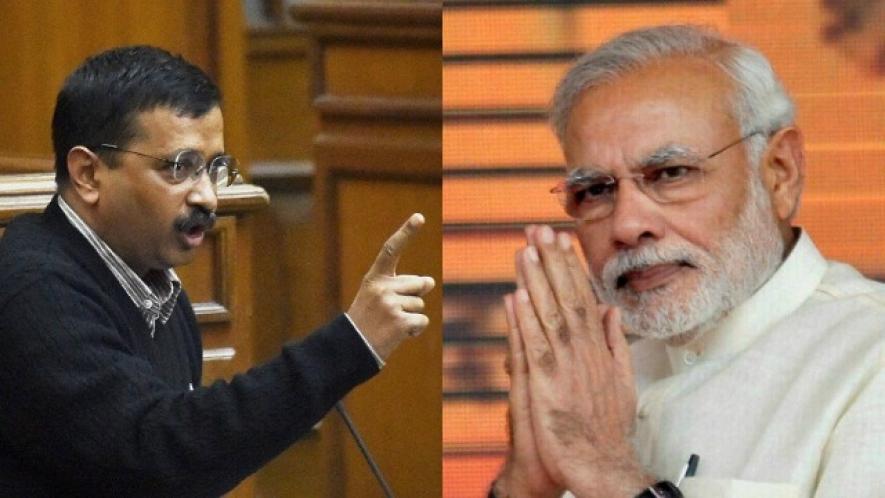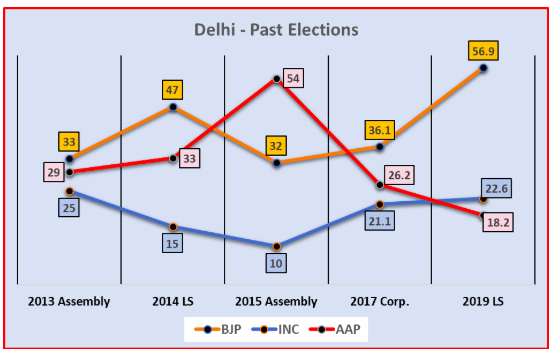Delhi Elections: It’s AAP vs BJP, But BJP Has its Back to the Wall

With the last date for nominations over on January 21, the stage is set for a battle royale in Delhi’s Assembly elections, scheduled for February 8. In the fray are three contenders -- Aam Aadmi Party (AAP), which is currently in the government; Bharatiya Janata Party (BJP) and the Congress (INC). A host of other parties will also be in the fray but usually they don’t matter.
The election is crucial on many counts. The fledgling AAP, which made its debut in 2013 and formed a short-lived government with the support of Congress, won the last election in 2015 with a stunning sweep. It won 67 out of 70 seats and got an incredible 54% of the votes. Remember that BJP had swept to power at the Centre just a few months ago and Prime Minister Narendra Modi was at his peak.
In the 2014 Lok Sabha elections, BJP had got 47% votes, winning all seven seats in Delhi. But in the 2015 Assembly elections, its vote share plummeted to just 32%, a dip of 14 percentage points, despite BJP’s full propaganda blast in Delhi.
The other significant aspect of the 2015 election was the decimation of Congress, which had ruled Delhi for 15 years before that. Its vote share plunged to a mere 10%, and it won no seat.

Changing Voters
But Delhi has a long history of switching sides. It may look whimsical and difficult to predict, but the bottom line is that Delhiites vote differently in different types of elections, as can be seen in the chart above.
So, after giving the Modi-led BJP a sweep in the 2014 Lok Sabha elections, they swung away and voted AAP into state government in 2015. It appeared that they were preferring BJP over Congress in the Lok Sabha but decisively giving the thumbs up to AAP and rejecting the same BJP for state government.
But the story goes further. In 2017, elections were held for the three municipal corporations in Delhi. This is the lowest tier of governance in the state (which is technically a Union Territory, but with an Assembly). In these Corporation elections, BJP won majority in all three and their combined vote share was about 36%. AAP, which had been ruling Delhi for over two years till then, suffered a humiliating defeat, getting only 26% votes, while Congress improved its dismal showing earlier by getting 21% votes.
In fact, it is this surge in Congress votes in the 2017 corporation elections that ensured that BJP won majority seats in the three local bodies. It was a genuine three-way fight, unlike the previous two elections (Lok Sabha and Assembly).
Finally, in the 2019 Lok Sabha elections, the clock turned back a full circle, with BJP again sweeping in all seven seats and getting 56.9% votes, just short of the previous record of Congress winning 57% way back in 2009.
Another feature of the 2019 elections was that AAP’s vote share slid down to just 18%, lower than Congress’ 22.6%. Clearly, there seemed a revival of Congress, starting from the 2017 Corporation elections and then the 2019 Lok Sabha elections.
The Reasons for Shifting Preferences
Going by these election results since the emergence of AAP in 2013, it appears that people in Delhi generally prefer the two national parties -- BJP and Congress -- but for the state Assembly, they are plumping for AAP. In the sole Corporation election, it was all divided up between the three parties.
Here, another factor needs to be noted. AAP has completely changed gears since the 2017 loss in the Corporation elections. Till then, it had devoted much energy to fighting the Central government because under Modi, the BJP could never stomach the stinging defeat of 2015. It had gone hammer and tongs at the AAP government, harassing it through its powers over various issues related to Delhi and using the central bureaucracy to stifle it. In response, AAP, led by Arvind Kejriwal, had been doggedly fighting for full statehood. There was much drama and fireworks.
But the Corporation defeat woke up Kejriwal. He completely changed the focus to ‘development’ which did have a populist orientation but it also delivered much needed relief to Delhi’s vast underclass that remains invisible in all the razzle-dazzle. In quick succession, measures like drastic cuts in water and electricity tariffs were announced, school education was overhauled by a steep increase in allocation for education, and subsequently, attempts to address other key issues, like healthcare delivery, transport etc., were taken up.
Advantage AAP
However, AAP has ignored various other serious issues of the Capital, including wages and social security for workers, including the vast unorganised labour that throngs and runs the metropolis. It has not thrown its weight for cheaper transport, allowing Metro fares to be hiked in 2018 and, typically, it tried to compensate for this by declaring free public bus rides for women. It has also generally managed the finances better than the previous Congress governments.
All this has led to the consolidation of the poorer and lower middle-class sections largely, though not solely, with AAP. The party has been careful in toning down its rhetoric against Modi and the Central government, hoping to gain support at the state-level from those sections who are with Modi at the national level.
Although AAP has not really endeared itself to the Muslim community in Delhi because of the lukewarm response to the anti-CAA-NRC-NPR (Citizenship Amendment Act, National Register of Citizens, National Population Register) protests, the community is likely to support Kejriwal, as he has the best chance of defeating BJP.
A key factor is the performance of Congress. If the party’s vote share was to increase, BJP would be happier, as AAP would lose that many voters. But this is unlikely, and the previous Corporation and Lok Sabha results should not be used as an indicator.
Meanwhile, BJP itself is in shambles in Delhi despite Modi and Shah’s attention. They have no unified leadership in the state, no plan and in the current atmosphere of hostility towards CAA-NRC-NPR, slipping support among the younger generation. So, as of now, it is advantage AAP.
Get the latest reports & analysis with people's perspective on Protests, movements & deep analytical videos, discussions of the current affairs in your Telegram app. Subscribe to NewsClick's Telegram channel & get Real-Time updates on stories, as they get published on our website.
























